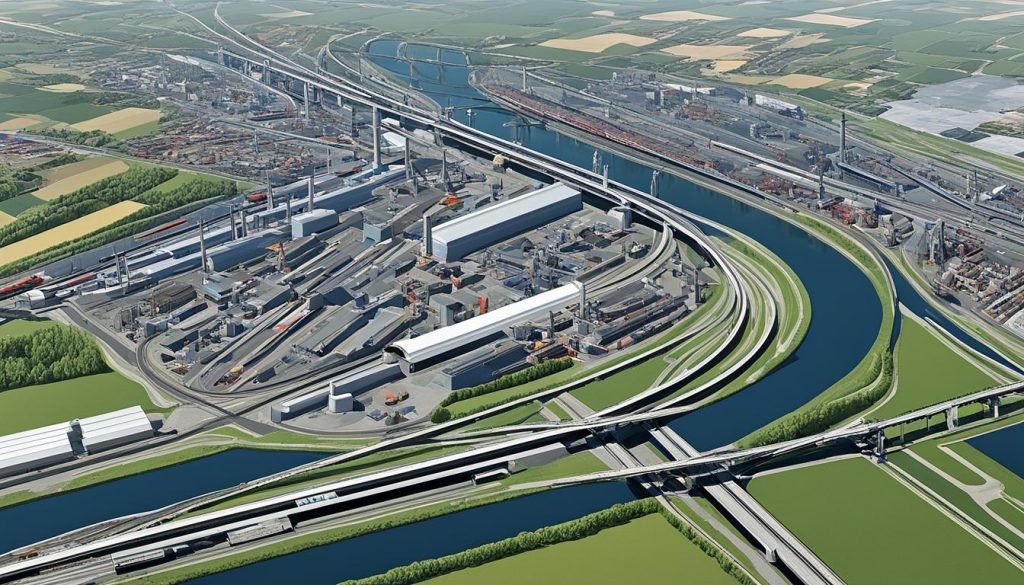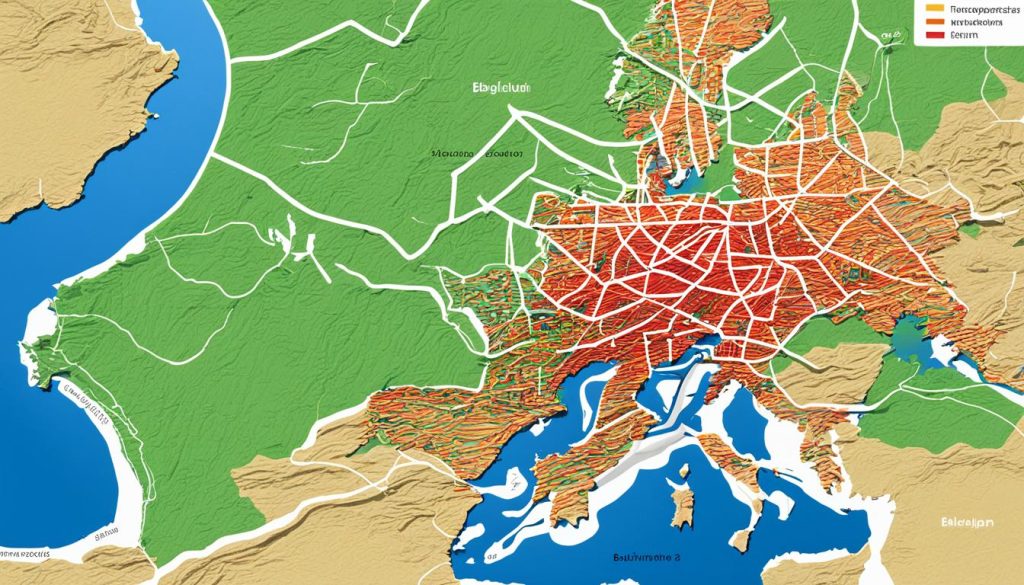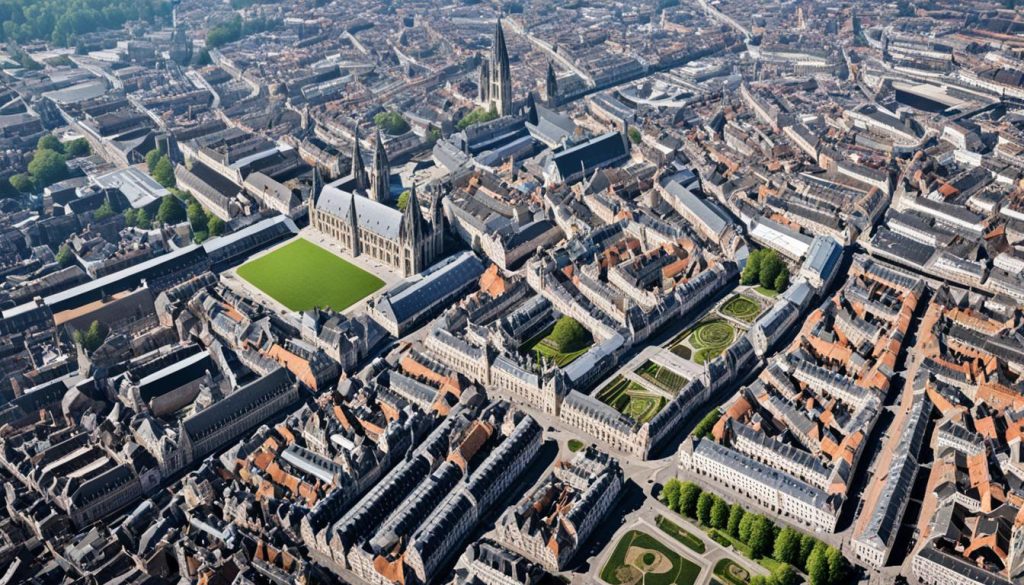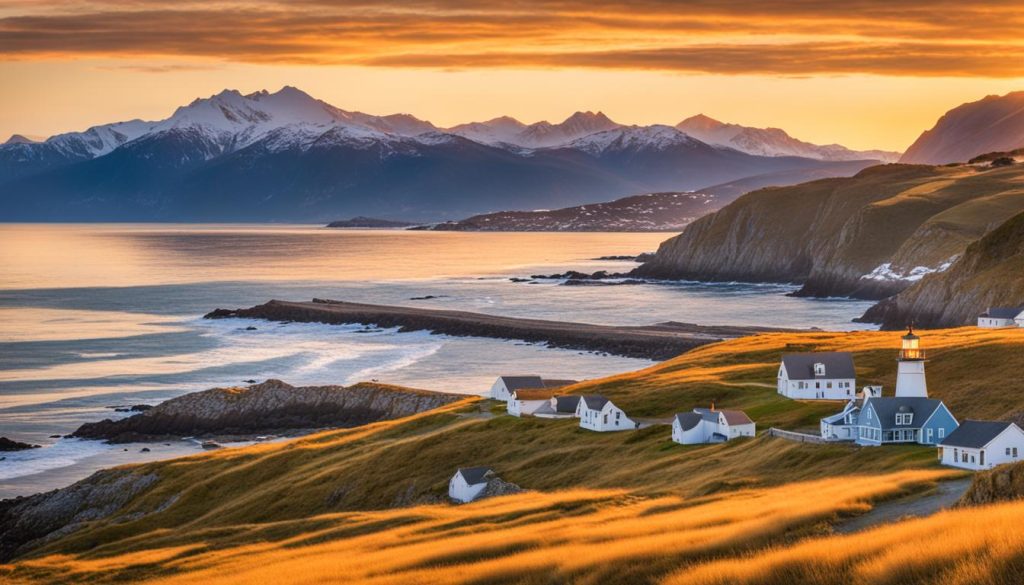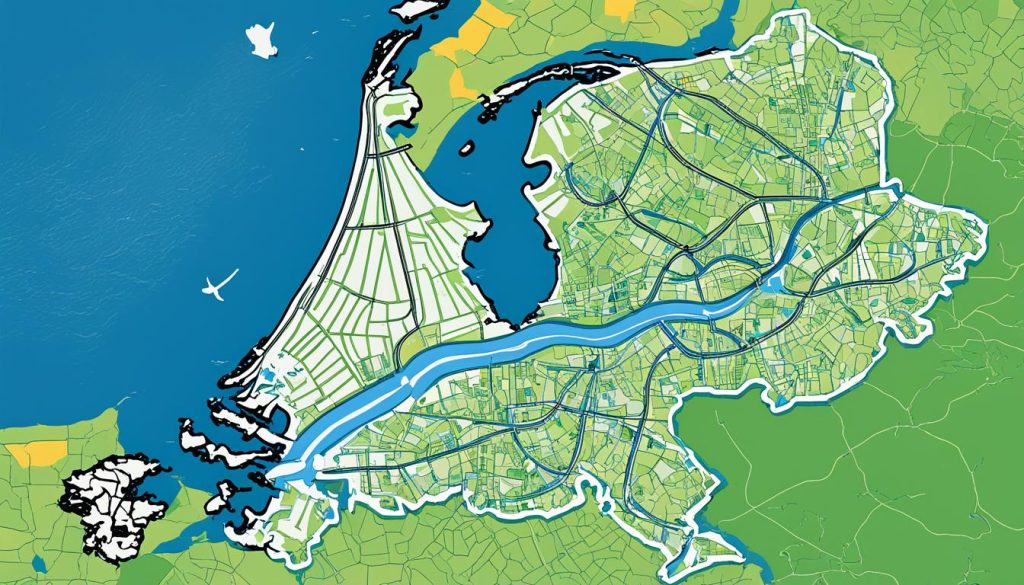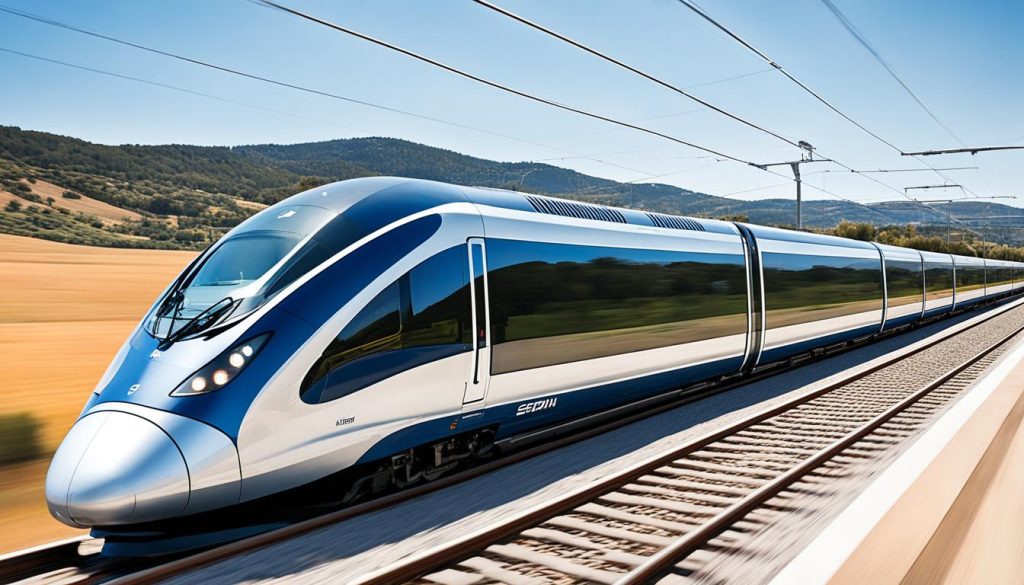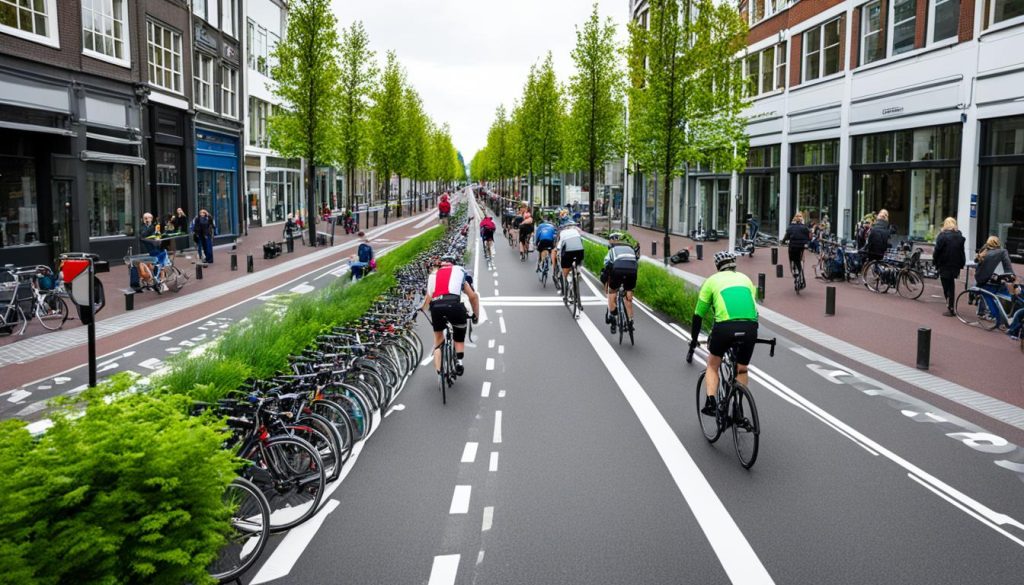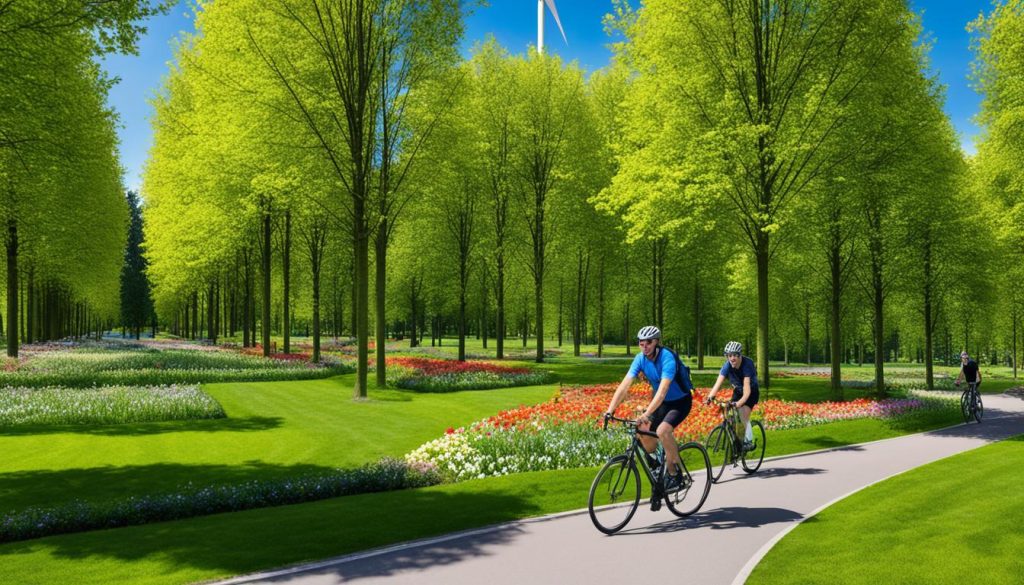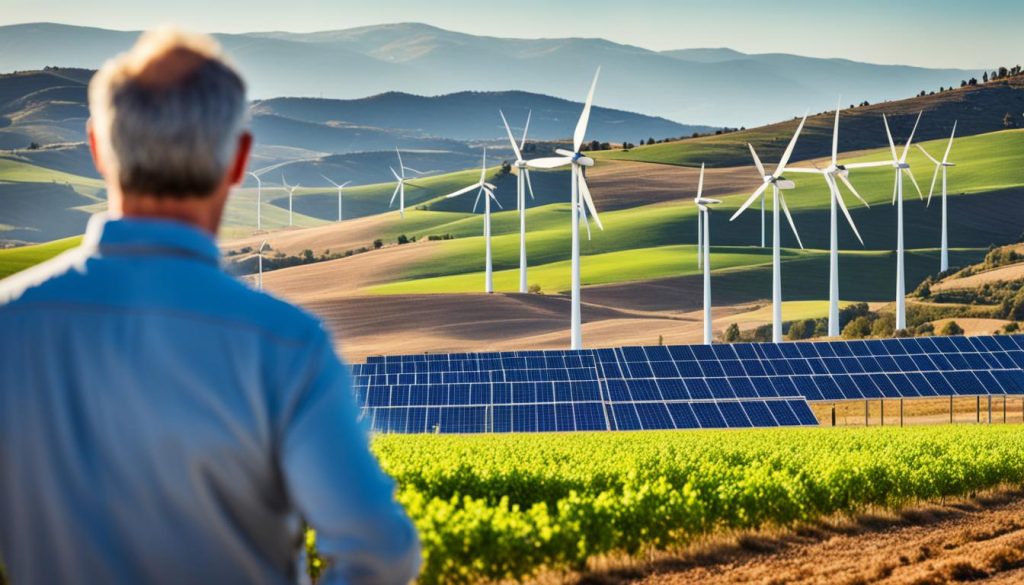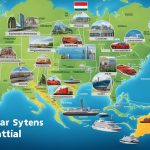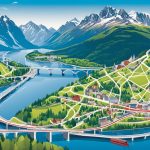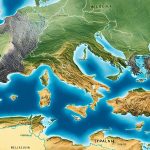Europe’s diverse geography and infrastructure are well shown by Belgium, Spain, and the Netherlands. Each country highlights a balance of natural and man-made structures. Belgium, for example, has a highly efficient infrastructure. This makes it key in Western Europe’s cities.
Spain, on the other hand, shows a mix of dry areas and green coastlines. This variety is both beautiful and challenging. The Netherlands is known for its excellent network of waterways and bike paths. These are essential to the country’s culture and economy. Looking at these countries shows how geography and infrastructure influence their life and growth.
Introduction to the European Trio’s Geography and Infrastructure
Exploring the European geography reveals the unique qualities of Belgium, Spain, and the Netherlands. Each country boasts different geographical features. These features have shaped their infrastructure, showing a connection between nature and human innovation. This connection highlights their strong roles in Europe.
When we look at their infrastructure, Belgium’s dense urban areas stand out compared to Spain’s diverse terrain, which varies from dry areas to green coasts. In contrast, the Netherlands impresses with its flat lands, criss-crossed by canals and dykes. These features show how each country’s geographical traits influence their infrastructure.
- Belgium’s focus on space efficiency has led to a well-organised transport network.
- Spain uses its wide landscapes to build features like long high-speed railway lines, mirroring its varied land.
- The Netherlands sees its waterways as links rather than obstacles, reflecting its control over the environment.
This overview of Belgium, Spain, and the Netherlands shows their commitment to technology and geography. They each address their unique geographical challenges. This shows the dynamic between their distinct landscapes and the infrastructure they have developed.
An Overview of Belgium’s Geographic Position
Belgium is at the heart of Western Europe, making it very important geopolitically. It’s at the meeting point of different European cultures and economies. This makes Brussels a key place for the European Union and NATO. Belgium’s location is vital for understanding Europe’s geography and how cities and people spread out in the area.
Central Role in Western Europe
Belgium’s geography is strategic, lying close to many Western European capitals. All less than 1000 kilometers from Brussels. This makes Belgium central to international cooperation and talks. It shows how important Belgium is in the geography of Western Europe and in broader continental matters. The country’s transport system is crucial for moving people and goods in Europe.
Urban Concentration and Population Density
Belgium has a lot of urban areas, which creates a contrast with its rural places. It’s one of the most densely populated countries in the world. This shows how many people live in cities. About 97% of Belgians live in urban areas. This move towards city life is due to growing city infrastructure and new chances.
- The pervasiveness of urban centers
- Adapting infrastructure to cater to dense populations
- Challenges of sustaining urban ecosystems
Belgium’s role as a key area in Western Europe’s geography is strengthened by these aspects. The move towards more urban living shows a bigger trend in the region. How Belgium deals with these urban challenges and opportunities is crucial to its future plans and development.
The Varied Landscapes of Spain
Spain is a country of diverse landscapes, stretching from the Iberian Peninsula. It ranges from rugged mountains to serene coastal plains. This diversity comes from its position on the peninsula. This makes Spain a prime spot for those who love nature and variety.
The Pyrenees in the north and the Sierra Nevada in the south show Spain’s varied topography. It’s not just about the landscapes, but how the climate, nature, and people interact. Yet, challenges like desertification and water scarcity call for strong environmental actions. Spain is working hard to tackle these issues.
- Spain’s Rich Biodiversity and Natural Reserves
- Desertification in the Interior Plateaus
- Water Management Initiatives
- Climate Adaptation and Renewable Energy Projects
The coastal plains have been key to Spain’s agricultural success. They offer fertile land for crops that feed the nation and boost exports. But, balancing economic gain with environmental care is tricky due to changing climates.
Spain understands the need to keep its landscapes beautiful and sustainable. It is putting money into eco-friendly practices. This also helps protect a rich cultural heritage that has grown in these natural settings.
- Conservation of the Coastal Plains and Beaches
- Agricultural Practices in Fertile Regions
- Promotion of Sustainable Tourism
Spain’s geography includes snowy mountains, Mediterranean beaches, green valleys, and arid plains. It’s a big part of what Spain is, driving its economy and future hopes. The country charms and challenges all, mixing innovation with tradition for future generations.
Netherlands: A Country Shaped by Water
The Netherlands is shaped by its battle with water. This country has mastered water management to keep its land dry. It sits below sea level, but is full of life thanks to its unique geography. The country’s landscape includes both flat lands and surprising hills.
The Ingenuity of Dutch Water Management
The Dutch use dikes and polders to make the land livable. This network keeps the country safe and supports its people. It shows how well they’ve adapted to living with water.
Diverse Terrain Despite Predominant Lowlands
Even though the Netherlands is known for its flat lands, it also has hilly areas in the southeast. These hills offer a contrast to the usual flat landscape. The country’s diverse geography reflects its complex relationship with land and water.
Transport and Connectivity in Belgium
Belgium’s dedication to top-notch Belgium transport greatly boosts connectivity across European transport networks. Even with traffic snarls and some investment shortfalls, the country shines in transport. Its ports, known for efficient deliveries, are pivotal for Belgium’s trade-focused economy.
The Belgian transport system is smartly placed, linking road and rail. This network not only makes Belgium self-sufficient but also a key part of Europe’s transport web. Let’s delve into the key parts of Belgium’s transport scene:
- Rail networks that tie major cities here to European capitals.
- A vast network of highways, ensuring quick trade across borders.
- Top-class ports like the Port of Antwerp, connecting to worldwide trade.
- World-class airports such as Brussels, for both people and freight.
- City transport with trams, buses, and metros.
This detailed setup caters to both Belgium’s own and Europe’s wider needs. Recognizing its central role, Belgium is enhancing its transport network. It’s boosting how Europe moves, showcasing unity through connected infrastructure.
Infrastructure Development in Spain
Spain is highly dedicated to upgrading its infrastructure. This has really put Spain on the map, thanks to better transport and logistics. The country has modernised its infrastructure, boosting both tourism and business. You can see major upgrades in high-speed trains and ports, showing Spain’s plan for a future-ready infrastructure.
Advancements in High-Speed Rail Networks
High-speed trains have changed how people travel in Spain. Spain boats one of the biggest high-speed rail networks in the world. This network connects remote areas with big cities, making travel quick and comfy. It’s helped Spain’s economy, provided eco-friendly transport, and improved connections within the country and with neighbours.
Modernisation of Ports and Airports
Spain has also focused a lot on improving its ports. This has reinforced Spain’s important spot in maritime Southern Europe. The ports have been upgraded with new tech and more space for international trade. This cements Spain as an important logistics centre. Airports too have been modernised to handle more visitors, making Spain a key point for global tourism and business.
Navigating the Netherlands: A Look at Transport Infrastructure
The Netherlands’ transport system shows their dedication to green policies and efficient trade. The country’s use of sustainable travel and creative waterway use showcases a society that respects both its past and its landscape.
Pioneering Bicycle Infrastructure
In bike infrastructure, the Netherlands leads by example. Bikes are key in their city transport plans. The many bike paths make travel easy for people and help cut down on pollution. This approach makes Dutch cities role models for how to design bike-friendly cities.
- Safe, segregated cycle lanes throughout city centres and countryside
- Ample bicycle parking, especially around major public transport hubs
- Integration with public transport systems for seamless travel
The Role of Inland Waterways in Commerce
The waterways in the Netherlands are vital for moving goods through Europe. Their advanced control of canals and rivers makes trade both sustainable and efficient. The Dutch have turned their waterways into a success story, blending trade with smart design.
- Efficient freight transport routes connecting to major ports
- Eco-friendly alternative to road transport, reducing traffic congestion
- Historical trade routes modernised for today’s logistics demands
Belgium’s Environmental Considerations
Belgium is dedicated to protecting our planet. It updates its environmental policies regularly, knowing these efforts go beyond its borders. It plays a key role in international eco-friendly agreements. This shows Belgium’s commitment to a safe planet for coming generations.
Belgium faces issues like air and water pollution. These come from its busy roads, industries, and farms. It knows it must balance growth with caring for nature. It’s moving towards green solutions, like clean tech, strict waste rules, and renewable energy.
- Promotion of electric vehicle usage through tax incentives and expanding charging infrastructure.
- Introduction of stricter air quality standards to reduce the impact of vehicular and industrial emissions.
- Implementation of water purification projects targeting agricultural run-offs and industrial effluents.
- Involvement in European Union-wide directives to significantly lower the carbon footprint of member countries.
- Enhancement of public transportation networks to provide more environmentally friendly alternatives to private cars.
The Belgian government and businesses work hard to be green. They tackle today’s environmental challenges and plan for the future. Belgium leads in fighting climate change, inspiring other nations.
Spain’s Geographical Challenges and Environmental Policies
Spain faces big environmental challenges. The threat of desertification and water scarcity requires a united effort. The country aims for a sustainable future. This has led to new solutions and practices at the heart of its plans.
Combating Desertification and Water Scarcity
Desertification is a big problem in Spain, risking its ecosystems. Projects to manage and restore land and water are crucial. They help keep soil fertile which is very important for farming and people’s health.
- Development of agricultural practices that reduce soil erosion and improve organic matter retention
- Investments in efficient irrigation systems that minimise water wastage
- Reforestation and afforestation programmes that strengthen the soil and act as natural barriers against land degradation
Renewable Energy Initiatives and Sustainable Tourism
Spain is investing more in renewable energy. Solar, wind, and hydro power will help reduce carbon emissions. Using renewable sources is key for cleaner energy and security.
- Expansion of wind farms across the Iberian Peninsula to harness its windy terrain
- Utilisation of Spain’s abundant sunshine with state-of-the-art solar energy technologies
- Incentives for homeowners and businesses to install renewable energy systems
Spain also promotes sustainable tourism. This protects its natural and cultural sites for the future. It involves measures to grow the economy while conserving nature. This makes tourism beneficial to the environment.
- Eco-friendly accommodation options that reduce the ecological footprint of tourists
- Investment in infrastructure that supports sustainable travel, including improved public transport and eco-trails
- Educational programmes aimed at raising awareness among tourists about responsible travel practices
Environmental Sustainability in Dutch Urban Planning
Environmental sustainability is key in Dutch urban planning. Dutch cities excel by sticking to eco-friendly rules. A lot of initiatives showcase their commitment to sustainability.
Amsterdam shines in environmental design. The city focuses on building with energy-saving in mind. Features like green roofing and energy-efficient tech are common.
- Dutch urban planning highly values green spaces. These places look good and support nature. They help keep the city’s climate in check.
- Eco-friendly travel is a big deal, with a push for cycling and public transport.
- Environmental design also upgrades old buildings. It makes them use less energy and emit less carbon.
This attention to eco-friendliness shows in better lives for people. The Netherlands’ careful planning in Dutch urban planning inspires cities globally.
Economic Impact of Geography and Infrastructure
Geography and infrastructure deeply influence a nation’s economy. For instance, Belgium excels in industry, while Spain leads in tourism. These cases show how geographical strengths can boost economic performance.
Influence on Trade and Industry in Belgium
Belgium’s strong economy comes from its industrial success. Positioned at the heart of Western Europe, its location aids a vast network of transportation and logistics. This enriches Belgium’s trade activities.
The Port of Antwerp stands out in Europe for cargo handling. It’s a key player in enhancing Belgium’s industrial sector through its bustling trade.
How Tourism Shapes Spain’s Economy
Tourism is vital to Spain’s economy, thanks to its varied culture and landscapes. Its beautiful beaches and historic sites draw millions of tourists yearly. This influx benefits the Spanish economy greatly.
Technological Innovations in Infrastructure Management
In the world of infrastructure technology, we see big changes that make our cities smarter and more connected. The move towards smart cities marks a big step. Here, the way we use data and manage traffic is key to making city life better.
Smart Cities and Traffic Management Systems
Smart cities are where technology and city planning come together. They aim to create intelligent traffic systems. These systems help lessen traffic jams, make public transport better, and encourage greener ways to travel. By predicting traffic and easing congestion, these solutions also help reduce car pollution.
Sustainable Development through Tech-Driven Initiatives
Tech initiatives are leading the way in making our cities more sustainable. They focus on green energy, better waste handling, and using the Internet of Things to run things more smoothly. These projects are part of a bigger plan to make our cities greener and more efficient. They fit into worldwide goals of building smart cities that are both tough and don’t waste resources.
- Deployment of smart grids that optimise energy distribution
- Integration of green spaces through urban landscape technology
- Implementation of smart lighting to reduce power consumption
Analysing Future Prospects in Geography and Infrastructure
Exploring the future of geography and infrastructure highlights the need for careful planning and climate adaptation. These are essential for growth that lasts. We need to think about how we affect the environment and the role of new technologies. These technologies will help shape both cities and countryside areas.
Projected Growth and Challenges
The projected growth in infrastructure brings both chances and big challenges. The move towards city living asks for new kinds of infrastructure, while the shape and form of the land call for clever planning to use space well. We must develop infrastructure that supports more people but also protects the environment and uses resources wisely.
- Expansion of renewable energy sources to reduce carbon footprints
- Integration of smart technology in transport networks to improve efficiency
- Enhancement of digital connectivity to support remote areas
The Impact of Climate Change on Future Planning
Getting ready for climate change is crucial in planning for geography and infrastructure. The weather is becoming less predictable, so we have to be ready for anything. We have to strengthen flood defences and make cities that can cope with heatwaves. Each step we take makes our infrastructure stronger and more flexible, ready for tomorrow’s climate.
- Implementing coastal protection projects to safeguard against rising sea levels
- Developing water conservation systems to prepare for drought conditions
- Constructing resilient buildings and transport systems to withstand extreme weather events
Detailed study and smart policy-making will make sure we make the most of geographical prospects. It will also ensure that future infrastructure is strong and lives in harmony with nature. How well we adapt and innovate will decide how successful we are in dealing with climate change.
Conclusion
As we conclude, we see how Belgium, Spain, and the Netherlands have uniquely tackled their geography and infrastructure. These countries show how they adapt to their environment. Belgium, for instance, uses its prime spot in Western Europe to boost its trade with a top-notch transport network.
This is despite its challenges with space and a high population. Spain, on the other hand, faces different terrain with lush areas and dry places. But it has thrived by creating policies and infrastructure, like its vast high-speed rail, that work well with its landscape.
This approach helps Spain’s economy by attracting tourists and supporting farming, with coastal areas key for trade. The Netherlands shines in managing water with its famous polders and dikes. This shows a perfect blend of nature and tech. Their excellent cycling paths also highlight their commitment to eco-friendly solutions.
In conclusion, looking at Belgium, Spain, and the Netherlands, we see their unique ways of using geography to promote growth and protect nature. Their efforts ensure a good life for future generations.
